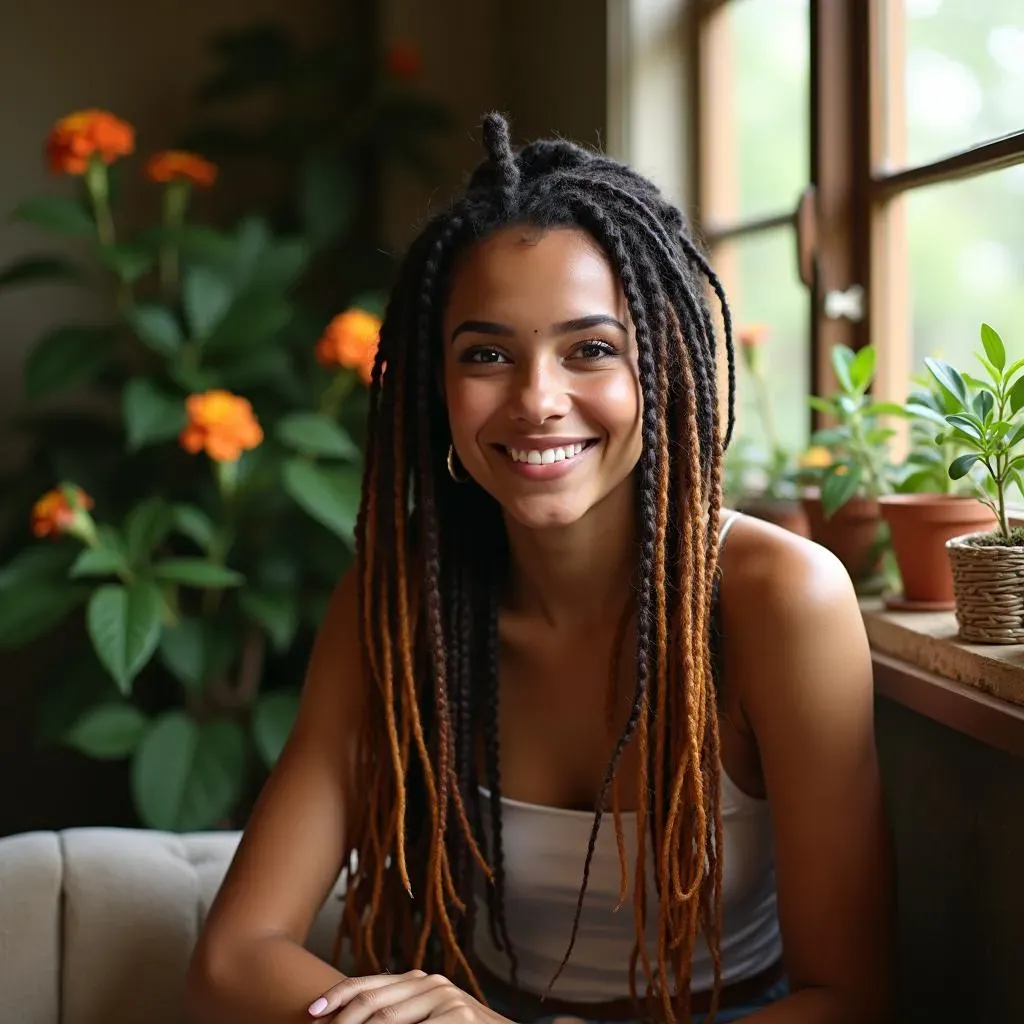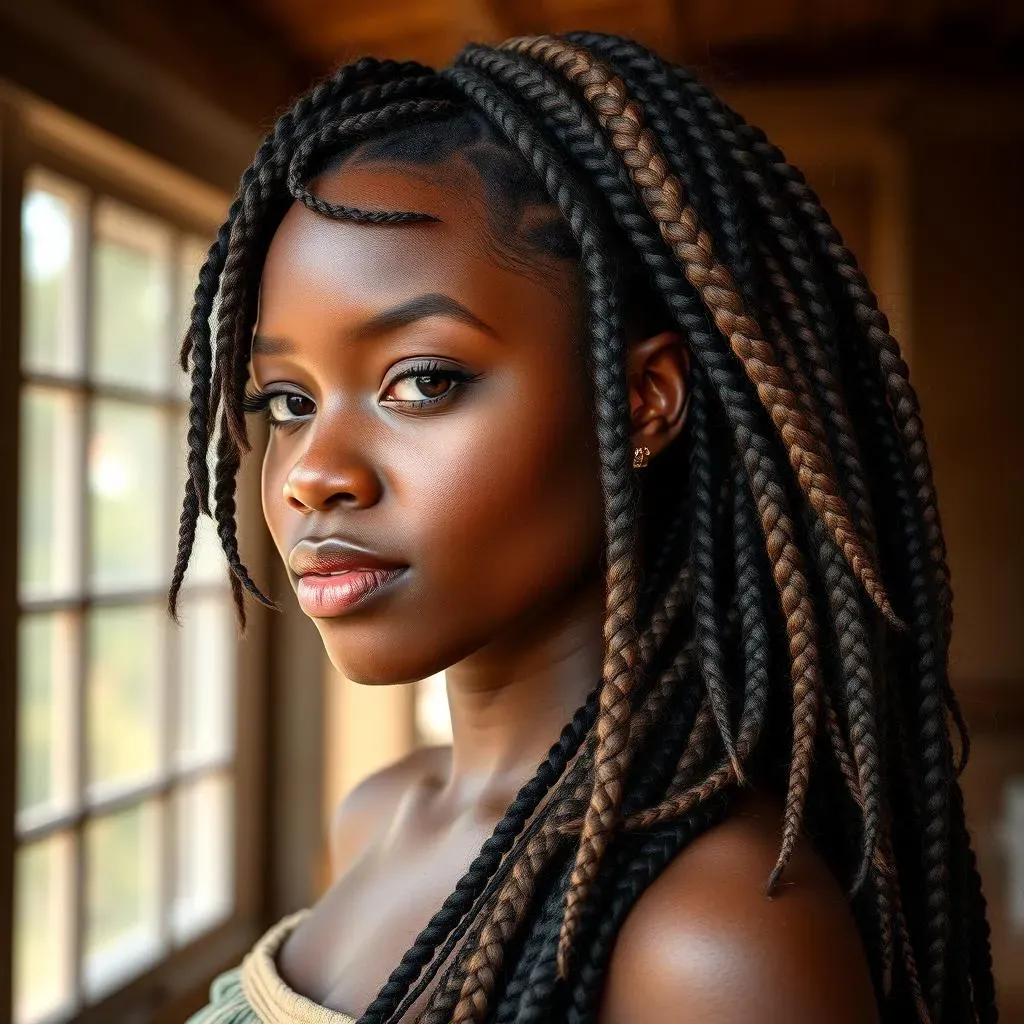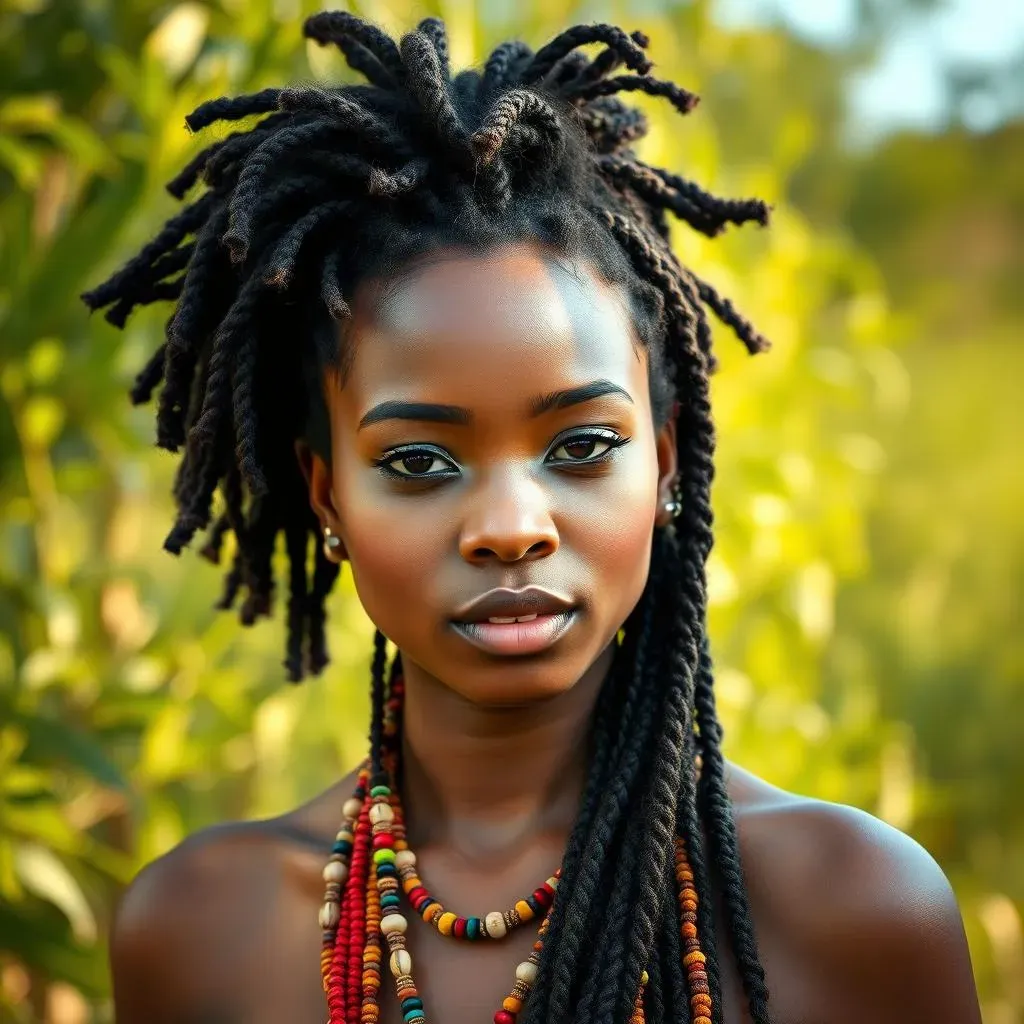Table of Contents
Ever seen someone with those amazing, textured rasta braids and wondered how they get that look? Or maybe you're already a fan, searching for tips to keep your rasta braids hairstyle looking fresh? Well, you've landed in the right spot! This isn't just another hair tutorial; it's your complete guide to understanding, styling, and maintaining those iconic braids. We're about to explore the rich history behind this hairstyle and learn about all the different ways you can rock it. From the classic techniques to modern twists, we'll get into the nitty-gritty. Thinking about giving it a try? We'll cover everything from choosing the perfect style for your unique look to the best ways to care for your braids so they stay gorgeous. So, buckle up and get ready to be inspired, because we're diving deep into the world of rasta braids hairstyle!
Understanding the Roots of Rasta Braids Hairstyle
Understanding the Roots of Rasta Braids Hairstyle
Beyond the Style: A Cultural Tapestry
Okay, so when we talk about rasta braids, we're not just talking about a cool hairstyle; we're stepping into a story that's been woven through generations. These aren't just braids; they're a symbol, a statement, and a connection to a rich cultural heritage. The term "rasta" itself is linked to Rastafarianism, a spiritual and cultural movement that originated in Jamaica in the 1930s. The long, often thick, and sometimes matted hairstyles associated with Rastafarians became a powerful symbol of their beliefs, which emphasize a connection to nature and a rejection of what they see as the oppressions of Babylon.
It's important to remember that hair can be a powerful form of expression, and for many, these braids are more than just a fashion statement. They represent a deep connection to their roots, their spirituality, and their identity. It's that kind of depth that makes this hairstyle so much more interesting than just a look, wouldn't you say? This is why understanding the history is so important, because it helps us appreciate the beauty and meaning behind the style.
From Rebellion to Recognition
Initially, rasta braids weren't exactly embraced by mainstream society. In fact, they were often met with prejudice and misunderstanding. Imagine that, a hairstyle causing such a stir! But over time, things started to shift. As the Rastafarian movement gained more visibility, so did its distinctive hairstyles. Think of it as a quiet form of rebellion, a way for people to express their individuality and cultural pride in the face of societal pressures.
It's pretty amazing to see how something that was once seen as controversial can become so widely celebrated. Today, rasta braids have transcended their original context and become a popular style worldwide. People from all walks of life wear them, sometimes as a nod to their heritage, sometimes simply because they love the look. It's this journey from rebellion to recognition that makes the story of rasta braids so compelling, don't you think? It's a powerful example of how culture and style can change and evolve over time.
Era | Significance | Social Perception |
|---|---|---|
1930s-1960s | Symbol of Rastafarianism, spiritual connection | Often met with prejudice and misunderstanding |
1970s-1990s | Growing visibility, cultural pride | Gradual acceptance, still some controversy |
2000s-Present | Global popularity, fashion statement | Widely celebrated, diverse interpretations |
The Evolution of the Look
Now, let's talk about how the style itself has evolved. What started as a relatively uniform look has branched out into a ton of different variations. You've got the classic long, thick braids, but then you also have smaller, thinner braids, braids with different patterns and designs, and even braids that incorporate beads, shells, and other decorations. It's like a blank canvas where people can experiment and put their own personal spin on things.
This evolution is a testament to the creativity and adaptability of the hairstyle. It shows how a cultural symbol can be reinterpreted and reimagined by different people in different times. I think that's what's so great about it, right? It's a style with deep roots, but it's also constantly evolving and changing. Whether you're drawn to the traditional look or want to try something more modern, there's a version of rasta braids out there for everyone. It's a style that's as diverse and multifaceted as the people who wear it.
Rasta Braids Hairstyle: Different Styles and Techniques
Rasta Braids Hairstyle: Different Styles and Techniques
Classic Rasta Braids: The Foundation
Alright, so let's get into the nitty-gritty of how these braids are actually made. When we talk about classic rasta braids, we're usually referring to long, thick braids that are created by sectioning the hair and braiding it tightly from the roots all the way down. These braids are sometimes called "dreadlocks," which is a term that also carries its own cultural weight. The classic style often involves backcombing or twisting the hair to encourage it to lock together, creating that signature textured look. Think of it as the OG style, the foundation upon which all other variations are built. It's the style that most people picture when they hear "rasta braids," and for good reason – it's timeless and iconic.
The process of creating these braids can take a while, depending on the length and thickness of your hair, and the desired size of the braids. It's not something you can just whip up in a few minutes, that's for sure! But the end result is a hairstyle that's both striking and deeply meaningful. People often choose this style as a way to honor their heritage or to express their individuality. It's a look that says, "I'm here, I'm bold, and I'm not afraid to be myself." And who wouldn't want that?
Variations on a Theme: Exploring Different Styles
Now, let's have some fun and explore the different ways you can tweak the classic rasta braid look. The beauty of this style is that it's so versatile. You're not stuck with just one option. Want smaller, more delicate braids? Go for it! How about adding some color? Absolutely! You can even incorporate different braiding patterns, like cornrows at the roots that transition into loose braids, or create intricate designs with the braids themselves. It's like having a hairstyle that's a work of art and you're the artist!
And it's not just about the braids themselves. You can also play around with accessories. Beads, shells, colorful threads, even pieces of fabric can be woven into the braids to add your own personal touch. It's a way to make the hairstyle truly your own, to express your unique style and personality. It's like taking a classic recipe and adding your own special ingredients to make it even more amazing. The possibilities are endless, and that's what makes this hairstyle so exciting!
Style | Description | Techniques |
|---|---|---|
Classic Rasta Braids | Long, thick, tightly braided strands | Backcombing, twisting, braiding from the roots |
Thin Rasta Braids | Smaller, more delicate braids | Smaller sections, tighter braiding |
Colored Rasta Braids | Braids with added color | Hair dye, colored extensions, threads |
Patterned Rasta Braids | Braids with cornrow roots or intricate designs | Cornrowing, various braiding patterns |
Caring for Your Rasta Braids Hairstyle
Caring for Your Rasta Braids Hairstyle
The Importance of a Good Wash
Okay, so you've got your rasta braids hairstyle looking fly, but let's talk maintenance, because that's key to keeping them that way. First up, washing. Now, I know what you might be thinking: "Washing braids? Isn't that a no-no?" Well, not exactly. You absolutely need to wash your scalp to get rid of buildup and keep things fresh. The trick is to focus on cleaning your scalp and the roots of your braids, rather than scrubbing the entire length of the braids. Think of it like you are washing your own hair, but with extra care. We don't want to cause any frizz or loosen the braids too much.
Use a gentle, sulfate-free shampoo, and dilute it with water before applying it to your scalp. This helps prevent the shampoo from being too harsh. Massage it in gently with your fingertips, and then rinse thoroughly. Don't be afraid to spend some time making sure all the shampoo is out. You don't want any residue hanging around. When it comes to drying, resist the urge to rub your braids with a towel. Instead, gently squeeze out the excess water or use a microfiber towel to pat them dry. This helps to keep your braids looking their best and also feels great on the scalp, trust me!
Moisture is Your Best Friend
Now that we've covered washing, let's talk about keeping your rasta braids hydrated. Moisture is your best friend when you have braids. They can get dry and brittle if not properly moisturized. Think of your braids like a plant, they need water to stay healthy and strong. A good way to keep them moisturized is to use a lightweight leave-in conditioner or a hair oil. Apply the product to your scalp and the length of your braids, focusing on the ends, where they tend to get the driest. You don't need to drench them, just enough to keep them from feeling parched.
Another tip is to wear a satin scarf or bonnet when you sleep. This helps to prevent friction, which can lead to dryness and breakage. It's a small change, but it can make a big difference in the long run. And don't be afraid to experiment with different products to see what works best for your hair. Every hair type is different, so what works for one person might not work for another. The key is to find a routine that keeps your braids feeling soft, supple, and healthy. It's all about keeping that moisture in and keeping the dryness out.
Care Step | Frequency | Product |
|---|---|---|
Washing Scalp | Every 1-2 weeks | Sulfate-free shampoo, diluted with water |
Moisturizing Braids | Daily or every other day | Lightweight leave-in conditioner or hair oil |
Night Protection | Every night | Satin scarf or bonnet |
Choosing the Right Rasta Braids Hairstyle for You
Choosing the Right Rasta Braids Hairstyle for You
Considering Your Hair Type and Length
So, you're ready to take the plunge and get some rasta braids, but where do you even begin? Well, the first thing to think about is your natural hair. What's your hair type? Is it fine, thick, curly, straight? This matters because it'll affect how the braids look and feel. If you have fine hair, you might want to go for smaller braids so they don't weigh your hair down. If you have thick hair, you can rock those big, bold braids. And what about length? If you have shorter hair, you might need to use extensions to get the length you want. It's all about finding a balance that works with what you've already got.
It's also a good idea to think about your lifestyle. Are you super active? Do you like to keep your hair out of your face? If so, you might want to opt for a style that's easy to manage and won't get in your way. Or maybe you're looking for a style that's more about making a statement. Whatever you're after, there's a rasta braid style that can fit the bill. It's like picking the right pair of shoes—you want them to look good, but they also need to be comfortable and practical for your everyday life. Trust me, a little bit of planning goes a long way in making sure your braids look their absolute best.
Matching Your Style and Personality
Now, let's talk about expressing yourself. Your rasta braids hairstyle should be a reflection of your unique personality and style. Are you drawn to the classic, natural look, or do you prefer something more bold and edgy? Do you love bright colors, or are you more into subtle, earthy tones? Think about how you usually dress and how you want your hair to complement your overall look. If you're a bit of a free spirit, you might love the bohemian vibe of loose, textured braids with beads and shells. Or if you're more of a minimalist, you might prefer sleek, uniform braids that are all about clean lines and simplicity. It's all about finding that sweet spot where your hair feels like an extension of who you are.
And don't be afraid to experiment! One of the best things about rasta braids is that they're so versatile. You can switch up the colors, the patterns, the accessories, and create a style that's totally your own. It's like having a blank canvas where you can express your creativity and show the world who you are. It's all about having fun with it, pushing your boundaries, and finding a look that makes you feel confident and awesome. After all, your hair is your crown, so wear it with pride!
Factor | Considerations |
|---|---|
Hair Type | Fine, thick, curly, straight |
Hair Length | Short, medium, long |
Lifestyle | Active, relaxed, professional |
Personal Style | Classic, bohemian, edgy, minimalist |
Wrapping Up Your Rasta Braids Journey
So, we've journeyed through the world of rasta braids hairstyle, from their cultural roots to the many ways you can style and care for them. It's more than just a hairstyle, it's a statement, a form of self-expression, and a nod to history. Whether you're a seasoned pro or just starting to explore this style, remember that the key is to find what works best for you and your hair. Don't be afraid to experiment, have fun, and most importantly, embrace the beauty and versatility of your rasta braids. Now go out there and rock those braids with confidence!
